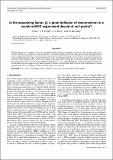Determining whether the squashing factor, Q, would be a good indicator of reconnection in a resistive MHD experiment devoid of null points
Abstract
The squashing factor of a magnetic field, Q, is commonly used as an indicator of magnetic reconnection, but few studies seek to evaluate how reliable it is in comparison with other possible reconnection indicators. By using a full, self-consistent, three-dimensional, resistive magnetohydrodynamic experiment of interacting magnetic strands constituting a coronal loop, Q and several different quantities are determined. Each is then compared with the necessary and sufficient condition for reconnection, namely the integral along a field line of the component of the electric field parallel to the magnetic field. Among the reconnection indicators explored, we find the squashing factor less successful when compared with alternatives, such as Ohmic heating. In a reconnecting magnetic field devoid of null points, our work suggests that Q, being a geometric measure of the magnetic field, is not a reliable indicator of the onset or a diagnostic of the location of magnetic reconnection in some configurations.
Citation
Reid , J , Parnell , C E , Hood , A W & Browning , P K 2020 , ' Determining whether the squashing factor, Q , would be a good indicator of reconnection in a resistive MHD experiment devoid of null points ' , Astronomy & Astrophysics , vol. 633 , A92 . https://doi.org/10.1051/0004-6361/201936832
Publication
Astronomy & Astrophysics
Status
Peer reviewed
ISSN
0004-6361Type
Journal article
Description
Funding: Carnegie Trust for the Universities of Scotland; Science and Technology Facilities Council (grants ST/S000402/1 and ST/P000428/1).Collections
Items in the St Andrews Research Repository are protected by copyright, with all rights reserved, unless otherwise indicated.

